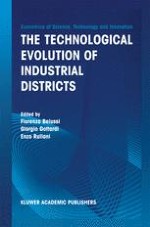Fiorenza Belussi, Giorgio Gottardi, and Enzo Rullani This volume collects some papers presented at the Vicenza conference "The Future of Districts", held in June 1999, organised by the Department of Technology and Management of Industrial Systems of the Faculty of Engineering of Padua University, with the collaboration of several engineers, industrial economists, and experts in the issue of technology management. This was the starting point of a long-lasting and painful colIective discussion, the results of which are documented here, during many meetings of this "itinerant" group, including the workshop in Padua, organised by Professor Luciano Pilotti and held in May 2001, "Systems, governance & knowledge within firm networks" at the Department of Economics of the University of Padua, and the recent international research seminar, held in May 2002, in Rome at the Tagliacarne Institute, within the EU sponsored project "Industrial districts' re location processes: identifying policies of EU enlargement West-East ID". The reason we decided to organise this book was not only to underline the importance of the industrial district (ID) model as a tool of propulsive local growth in a country like Italy. On the contrary, the idea that moved us was the theoretical dissatisfaction with the way in which the phenomenon of local development and industrial clustering of specific industries was treated in the international approach of the various disciplines.
